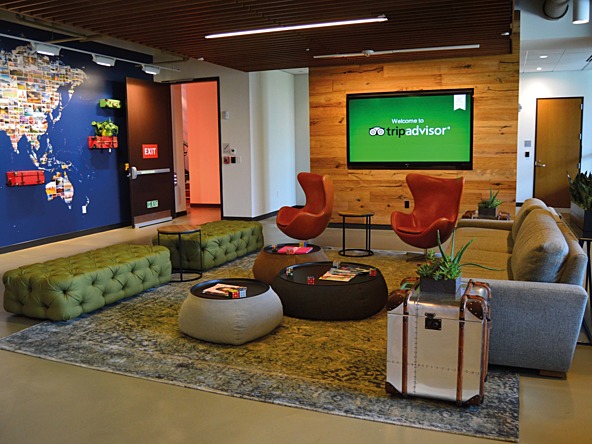FEATURE27 July 2022
Performance reviewed: Research at Tripadvisor
x Sponsored content on Research Live and in Impact magazine is editorially independent.
Find out more about advertising and sponsorship.
FEATURE27 July 2022
x Sponsored content on Research Live and in Impact magazine is editorially independent.
Find out more about advertising and sponsorship.
Tripadvisor uses professional insights to better understand prevailing travel trends and find out what consumers really want when they visit a particular destination. By Colette Doyle.

One billion – that’s a heck of a big number by anybody’s standards, but that’s the number of reviews that Tripadvisor had clocked up from its users by February this year. The travel guidance site, which was founded 22 years ago, says it hit the milestone through a combination of reviews, tips, photographs, likes, comments and posts.
“We were very excited to get there,” notes Tatiana Gonzalez, research and insights lead at the Massachusetts-headquartered company.
Gonzalez heads up the professional insights team that sits within the TAPS organisation – Tripadvisor Advertising and Partner Solutions. Although the focus for her six-strong team has traditionally been media, she works cross-functionally with other departments, such as communications, enterprise and hospitality, as well as operating “hand in hand” with analytics.
“We have, in fact, just hired for a role that will not be media-focused; its remit will instead be to work closely with other groups within the organisation, providing them with more ready access to insights and research,” she explains.
Having spent most of her career in New York, Gonzalez is currently enjoying a change of scene and working remotely in Galicia, northwest Spain, the country from which her family originates.
She is a veteran of the insights industry, having previously been head of video data and growth at Condé Nast Entertainment. Before that, she had a data analytics and market research remit at both Spotify and Google. With around 180,000 locations listed on the site, as well as 40-plus countries in which Tripadvisor has offices, her team of six has its work cut out and is tasked with covering Europe, the Americas and Asia-Pacific.
Such a structure helps immensely in terms of identifying and resolving the specific needs of partners in those territories, as Gonzalez explains: “It allows us to truly understand what a specific US agency might require, because we’ve dealt with those agencies before; or what Asia-Pacific needs for a particular tourism board. We get to capture the local nuance in a way that we might otherwise not be able to as a global company.”

There are three broad areas of focus for her team: the first involves Tripadvisor’s proprietary data. “It’s so comprehensive, given the scope of our audience, the millions of businesses that partner with us and all the countries we cover,” says Gonzalez. “So being able to access that gives us a really comprehensive picture of travel behaviours, planning and booking that I think is hard to beat in many ways.”
She continues: “A lot of what our team does is mine that internal data to better understand just how people are using Tripadvisor – everything from reviews and specific businesses to particular locations. We look at the top destinations being searched, booking windows, whether people are booking more immediate trips closer to home, or if they are booking further in advance, and how that has been affected by things like the pandemic. I think it really helps us make smarter decisions and understand trends in travel. What we see on the site is often reflective of what else is happening in the market, so we’re able to make insights and a clear narrative out of it.”
Gonzalez’s second purview goes deeper into the ‘why’ of this data. As well as working with internal data, her team commissions studies with vendors and trusted research partners to dig deep into consumer travel sentiment: how are people feeling about it, are they nervous, are they excited? They look at what travellers are planning, what they are filtering in their searches, and their spending habits.
Gonzalez offers this example: “We worked with Ipsos on a study that was published in Q1 and involved five markets, three of which were in Asia-Pacific. We were able to use that to look at the year ahead in travel and travel intent – that helped us to flesh out some of what we were seeing internally.”
One of the main findings of the study was a renewed appetite for travel now that restrictions have eased, and a desire to experience new destinations and locations, as opposed to returning to the familiar. “It gives us this additional level of context to go alongside what we’re seeing internally; it’s such a good mix. It provides us with a really robust position in the thought leadership space around the what, why and how of travel.”
The third remit involves managing the digital ad effectiveness arm of the company. This is where the team is focused on working with the sales department to quantify the effect of running a campaign on Tripadvisor, in tandem with an insights partner such as Nielsen or Kantar. Gonzalez explains that this goes beyond standard campaign metrics, such as clips and impressions, to measure other key performance indicators (KPIs) that might not be captured without this study, including brand awareness, or purchase intent, or conversions.
Not one to rest on its laurels, Tripadvisor overhauled this part of the business in March to explore partners beyond the ones it has historically used, to provide a more tailored approach.
“This was done so that we were able to represent different budget needs and KPI measurements, as well as different regions,” says Gonzalez, adding that the company is now in conversation with various advertisers to implement these effectiveness studies as part of their campaign buy. Like virtually all operators in the travel industry, Tripadvisor is building back from “an incredibly challenging time”, as Gonzalez acknowledges. “Now that we’re seeing a fuller recovery, the challenge continues to be the need to make sure we’re bringing the right insights to the right people, so that they can keep on growing their business – ‘A rising tide lifts all boats’, as they say.”

All through the pandemic, the company was still monitoring users’ travel habits to try to discover where their interest lay, whether that was safer road trips, camping, or outdoor destinations.
“Even at the peak of Covid-19, consumers were still engaging with us, posting on forums and saying, ‘I miss travel’, so the team’s mission was to pivot on to the travel that was possible,” says Gonzalez. “Now the goal is to figure out how we partner with the right people and make sure we get back to where we were.”
The requirement to create custom insights can be demanding, as she recounts. “Full credit to the analytics team, they have been able to build out a range of insight dashboards, which allows people in our organisation to access a variety of self-served data around specific destinations, regions and hotels, which is super helpful.
“But we still have to do a lot of custom work – it’s exciting, but it’s not a one-size-fits-all approach.”
Gonzalez acknowledges that, while travel is evergreen, that is not always the case with insights. “Sometimes, things we pulled last quarter, or even last month, might not be as relevant or might need additions, or something has shifted with time. The way we need to continuously update and rethink, or iterate, can be a challenge.”
Requests also come in all shapes and sizes, as Gonzalez points out. “Because we have so many requests, it might be a video chat, it might involve a Slack conversation, or it could be an email thread.”
Now that life is returning to normal, live events have re-entered the mix – and to good effect. “One of our senior managers has started attending in-person conferences again; he recently presented the results of a study that we did around travel dining at a quick-service restaurant conference in the US, and that was really well received. A lot of the speakers were coming in with very transactional presentations, ‘This is what my company does’, that sort of thing. But we ran this study through Qualtrics [a Seattle-based experience management agency] and that allowed us to look at their category in depth and give them an idea of trends in terms of really understanding what travellers who visit those types of restaurants want.”
This then informed the outlets’ marketing strategy, allowing them to target specific groups, from families to solo travellers and those on business trips. “There were lots of good insights and takeaways that came from that,” remarks Gonzalez.

Sometimes, clients like the takeaways presented as an infographic, and Gonzalez’s team is currently working on one for the World Bank of Indonesia. This, she explains, was a pure research project and not part of a media buy; it involved analysing internal Tripadvisor data on behalf of the bank over a period of three months for specific locations of theirs that they want to promote more. “They weren’t paying for media – they weren’t paying for that exposure; they were really after a data partnership.”
There were a lot of moving parts to the project, as she recalls. “We made sure that the owners were approaching listings the right way: whether they were claimed, whether they weren’t, what types of reviews they had received, how owners were managing the brand.” The upshot was a huge improvement in destination performance and a significant uplift in visibility for the properties in those key regions.
In terms of sharing the data produced by her team, one crucial point comes in the shape of ensuring that the insights are easily understandable for everyone involved, as Gonzalez elaborates. “This is something that I think every research team deals with; there’s this line that we walk on a daily basis – the need to be rigorous with data, but then you have to distil it enough to make sure it’s suitable for the range of stakeholders you work with.
“You have to pick out what is needed for specific people, so their eyes don’t glaze over when you’re basically giving them a thousand charts.
“When we show a chart, our practice is to have a clear headline that actually says something about the results, like a key takeaway that the person viewing it should be focused on, as opposed to, ‘Here’s a whole load of numbers.’”
As she concludes: “You need to remember that they are not always data people; often, they might be a junior agency person, or somebody working with a government body. We always have to keep that at the forefront of our minds – it’s essential to make the data digestible.”
This article is from the July 2022 edition of Impact magazine.

0 Comments